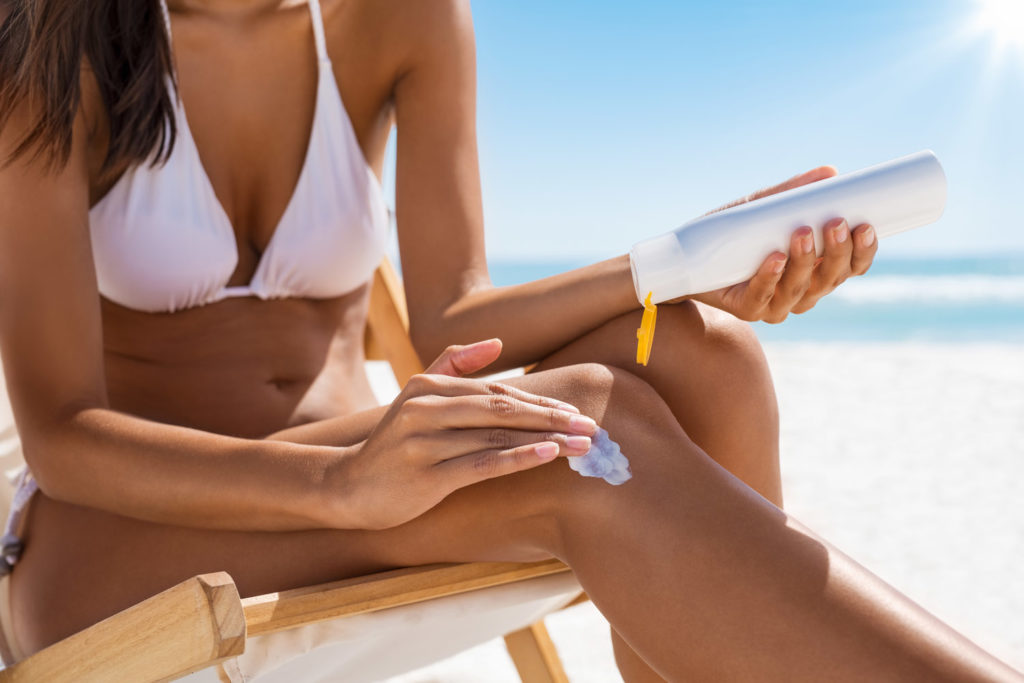The sun releases many kinds of radiation, each with a wavelength band that is specified. As soon as UVR reaches the skin, it is readily absorbed by the skin molecules that intermingle more intensely with a specific wavelength.
This act may result in damaging the skin proteins, lipids, and cellular DNA, eventually leading to skin cancer if sunscreen is not used. Ultraviolet radiation is broken into three types of wavelengths:
- UV-A: The longest wavelength is not absorbed by the ozone. It deeply penetrates the skin.
- UV-B: It is blocked partially by the ozone layer and is accountable for sunburns.
- UV-C: This is entirely absorbed by the atmosphere; it can only be encountered from artificial radiation sources.
1. Sunscreen
Sunscreens can absorb or redirect these harmful rays before they can interact with the skin. A sunscreen product will typically contain a combination of chemical and moisturizing ingredients. Certain ingredients are much better in blocking UVB while others block UVA.
Chemical sunscreen ingredients PABA esters, cinnamates, para-aminobenzoic acid (PABA), benzophenes, salicylates, octocrylene and dibenzoyl-methane. Titanium dioxide and zinc oxide are physical blockers and board spectrum which block both UVB and UVA.
2. What is SPF?
Stands for Sun Protection Factor. The number is determined and established by the degree of light that stimulate and encourages redness in skins that are sunscreen-protected, divided by the degree of light that encourages redness in skins that are not protected is the SPF. It is simply a measure of protection from UVB which ranges from 1 to 45 or above.
A sunscreen product having an SPF of 15 will filters 92 percent of the UVB. Or, a sunscreen product having an SPF of 15 will defer the beginning of a sunburn in an individual who would burn in 10 minutes to burn in 150 minutes. The SPF 15 sunscreen can allow an individual to remain in the sun 15 times longer.
3. Sunscreen Application And Selection Tips
- Before buying a sunscreen product, read the label and be sure that it will filter and absorb both UVA and UVB.
- Check also the products level of protection. SPF 15, or 30, depending on how long you usually stay out in the sun.
- Keep in mind that inexpensive brands are just as effective as expensive brands.
- Check the expiration date. An expired product will lose its potency thereby will not perform its role. This could lead to serious sun burn.
- Choose a product too, that is labeled board spectrum, to give your skin complete protection from UVB, UVA and UVC.
- Remember that lighter skin will burn more quickly than darker skin. Therefore light skinned individuals needs higher SPF.
- The product should comply and abide with the standard AS/NZS2604 to support their claims and declaration for SPF, water resistance and board spectrum. This should be in their label.
- Check the products formulation. It must be non-allergenic so it is safe to use on sensitive skin and on the face as well as nonacnegenic so as not to clog the pores.
- Insist on a product that is PABA free, contains no irritating chemicals, and is safe to use on the face.
- A water proof sunscreen is best.
- Read the label and make sure that aside from sun protection, it also contains essential skin moisturizers to nourish your skin at the same time.
- Before applying a sunscreen, the skin should be clean and dry so that it can be well absorbed.
- Apply a liberal amount of sunscreen all over the body and pay special attention to the face, nose, ears, cheeks, and scalp as these are areas that are prone to sun burn.
- Reapply often, when perspiring heavily or after swimming. It is best to apply it fifteen minutes before you go out in the sun.
- Even on cloudy days, there is still a need for sunscreen application.
- Even with a sunscreen, avoid the sun during the hottest hours of the day starting at ten in the morning until four in the afternoon.
- Reflectors like zinc cream that reflects UV rays off the skin, should only be applied on small areas of the skin as they tend to limit perspiration.



